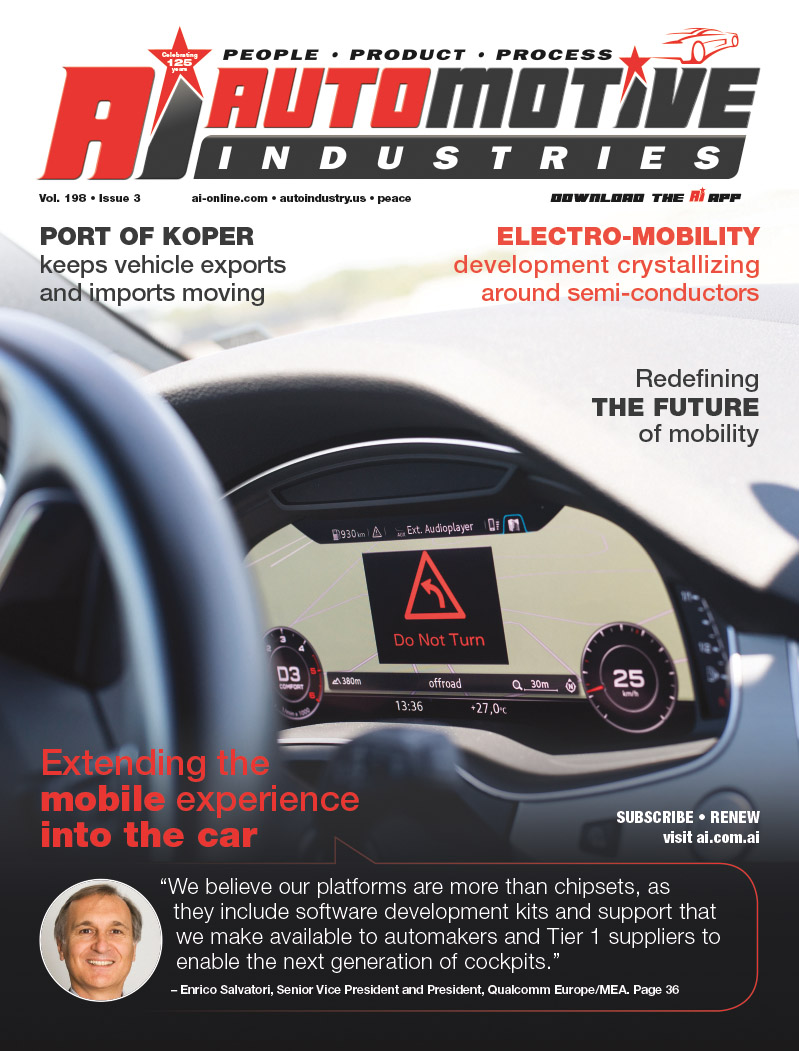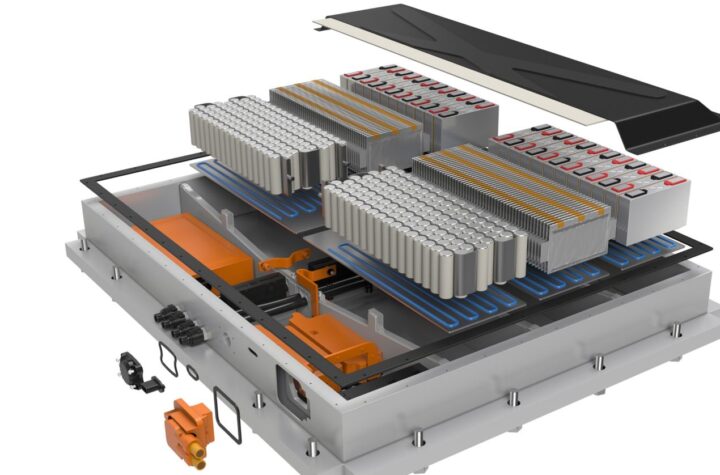
Change in the automotive industry is being sped up by the exponential growth of technology such as 5G.
With 3G and 4G, the automotive world was introduced to things like roadside assistance, location technologies, cellular connectivity, and infotainment. These enabled services like OnStar, and later helped give birth to ride-sharing companies, like Lyft and Uber, and community-based traffic and direction apps, like Waze. D
riving these innovations beneath the hood, all major automakers use products from Qualcomm Technologies’ portfolio of automotive solutions across telematics, infotainment and connectivity areas.
Automotive Industries (AI) asked Enrico Salvatori, Senior Vice President and President, Qualcomm Europe/MEA, what smart technology and solutions the company offers. Salvatori: Qualcomm Technologies is helping the automotive industry create an entirely new landscape for communication, convenience, energy efficiency, infotainment, and safety. Our scalable, modular solutions help carmakers integrate cutting-edge wireless and computing technologies into today’s connected cars. Qualcomm Technologies’ suite of smart technology and automotive solutions allows car manufacturers to expand their existing accessory package offerings to include advanced on-board features, such as connectivity, infotainment, navigation and driver safety. We strongly believe our platforms are more than chipsets, as they include software development kits and support that we make available to automakers and Tier 1 suppliers to enable the next generation of cockpits.
AI: How do you help carmakers integrate cuttingedge wireless and compute technologies into today’s connected cars? Salvatori: Inside the automobile is where the alwaysconnected lifestyle intersects with true mobility. We extend the mobile experience into the car by bringing many of the features and experiences found in smartphones – including multi-gigabit LTE and 5G connectivity, touch screen display, advanced graphics, streaming media and HD video. Qualcomm® Snapdragon™ Automotive Solutions brings connected car features to life with platforms designed specifically for automobiles.
AI: How is C-V2X – cellular vehicle-to-everything assisting in the evolution of vehicle communication? Salvatori: C-V2X is an important technology for improved road safety, traffic efficiency and the future of autonomous driving. It complements the capabilities of other ADAS sensors by providing 360-degree non-line-of sight awareness, while creating an evolutionary path to 5G NR based C-V2X for autonomous driving. C-V2X momentum continues to build with a broad ecosystem support due to its superior performance, cost effectiveness and 5G compatibility. Rel-16 5G NR C-V2X will add the high throughput and URLLC capabilities for tomorrow’s autonomous driving use cases, such as intention sharing for advanced path planning. C-V2X works with 4G and is forward compatible with 5G.
AI: Is 5G here? Salvatori: Yes. Qualcomm has been working on 5G for 10+ years – inventing, driving standards, proving concepts, and enabling our partners to be successful. Over the last few months operators and OEMs officially launched commercial 5G networks and devices, which means the global rollout of this new generation of wireless is fully underway — one year ahead of schedule. For example, Swisscom launched the first commercial 5G network in Europe in April, followed by Sunrise, EE, Vodafone, TIM, DT and Elisa. And as with previous generations of mobile networks, it will take time to proliferate. 4G LTE will continue to serve as the anchor for the 5G mobile experience.
AI: What will 5G let you do? Salvatori: 5G will be the connectivity fabric for the future of automotive and the emergence of a supporting smart transportation system. We will rely on 5G to share information in ways we weren’t able to with any previous mobile technology, and it’s this reliability that will kick-start exponential innovation across the sector. Almost 20% of the projected global impact of 5G relates to the broader automotive sector (worth more than US$$2.4 trillion in economic output by 2035). Furthermore, 5G’s ability to enable faster speeds, reliability and responsiveness will deliver tangible benefits for car users, including extreme broadband for new in-car experiences (AI, VR, etc.), and real-time HD mapping updates and teleoperation needed for autonomous driving. It could also transform conventional models of car ownership and transportation itself – providing opportunities to automakers, technology firms and content providers.
AI: How important is 5G to the rollout of autonomous vehicles? Salvatori: It is true that 5G network communication will redefine the automotive industry by offering multi-gigabit speeds for immersive user experiences, as well as new infotainment, telematics and teleoperation use cases. However, 5G will also define a communication mode that will allow cars to communicate with each other directly for autonomous driving use cases. This mode of operation can operate without dependency or reliance on wide area network coverage. Autonomous vehicles rely on several different kinds of sensors to be able to detect and infer their surroundings and road conditions. While sensors such as radar, and camera systems are essential, these sensors are limited by their line-of-sight (LOS) operation. Rel-14 C-V2X direct communication complements the capabilities of these sensors by providing 360-degree non-LOS (NLOS) awareness, extending a vehicle’s ability to detect farther down the road — even at blind intersections or in poor weather conditions. The high throughput and reliability of 5G NR C-V2X will enable autonomous vehicles to directly share their perception of the road, road conditions and surroundings with each other and with road infrastructure. These capabilities will allow the vehicles to build a real-world and real-time model of the surrounding environment.
AI: What does the membership in 5G Automotive Association bring? Salvatori: The 5G Automotive Association (5GAA) is a global, cross-industry organization bringing together the automotive, and information and communications technologies (ICT) industries, in order to develop end-to-end connectivity solutions for intelligent transportation, mobility systems and smart cities. Created in September 2016, 5GAA unites more than 85-member companies from all segments and regions. Since its inception, 5GAA has rapidly expanded to include key players with a global footprint representing all major industry players around the world. This includes automotive manufacturers, Tier-1 suppliers, chipset/communication system providers, mobile operators and infrastructure vendors. 5GAA’s mission is to develop, test and promote communication solutions, initiate their standardization and accelerate their commercial availability and global market penetration, to address society’s connected mobility and road safety needs with applications such as automated driving, ubiquitous access to services and integration into smart city and intelligent transportation. This mission is achieved by:
• Developing, testing, and promoting communications solutions
• Initiating their standardization for global market penetration and ensuring commercial availability of relevant applications such as autonomous driving, ubiquitous access to services and integration into smart city and intelligent transportation
• Defining and harmonizing use cases, business and go-to-market models for automotive and intelligent mobility applications, including rental cars, car sharing and electric vehicles
• Elaborating technology selection and a roadmap evolution strategy including spectrum allocation requirements.
AI: What’s next for Qualcomm? Salvatori: Artificial Intelligence brings the automotive and the entire transportation industry to the next level. By making devices, machines, automobiles and things more intelligent, it is simplifying and enriching our daily lives. It will transform the collection and analysis of data from vehicles to provide remote diagnostics and smart feature updates. We will see development such as the “Intelligent Cockpit” with driver monitoring or personal assistant applications, as well as “Smart Transportation” consisting of smart infrastructure for safety and traffic efficiency. And, finally, it will help the automotive industry in the transition to autonomous driving. Combining AI computing capabilities with the benefits of 5G will deliver new services and applications, such as autonomous driving and smart transportation. These applications will improve people’s productivity, safety and the efficiency of the transportation systems.












More Stories
Automotive Industries (AI) Newsletter April 2025
GlobalLogic Pioneering Software-Defined Vehicles, AI Innovation, and Sustainable Solutions for the Future of Automotive Mobility
Cybord TCI – The Future of Manufacturing Integrity